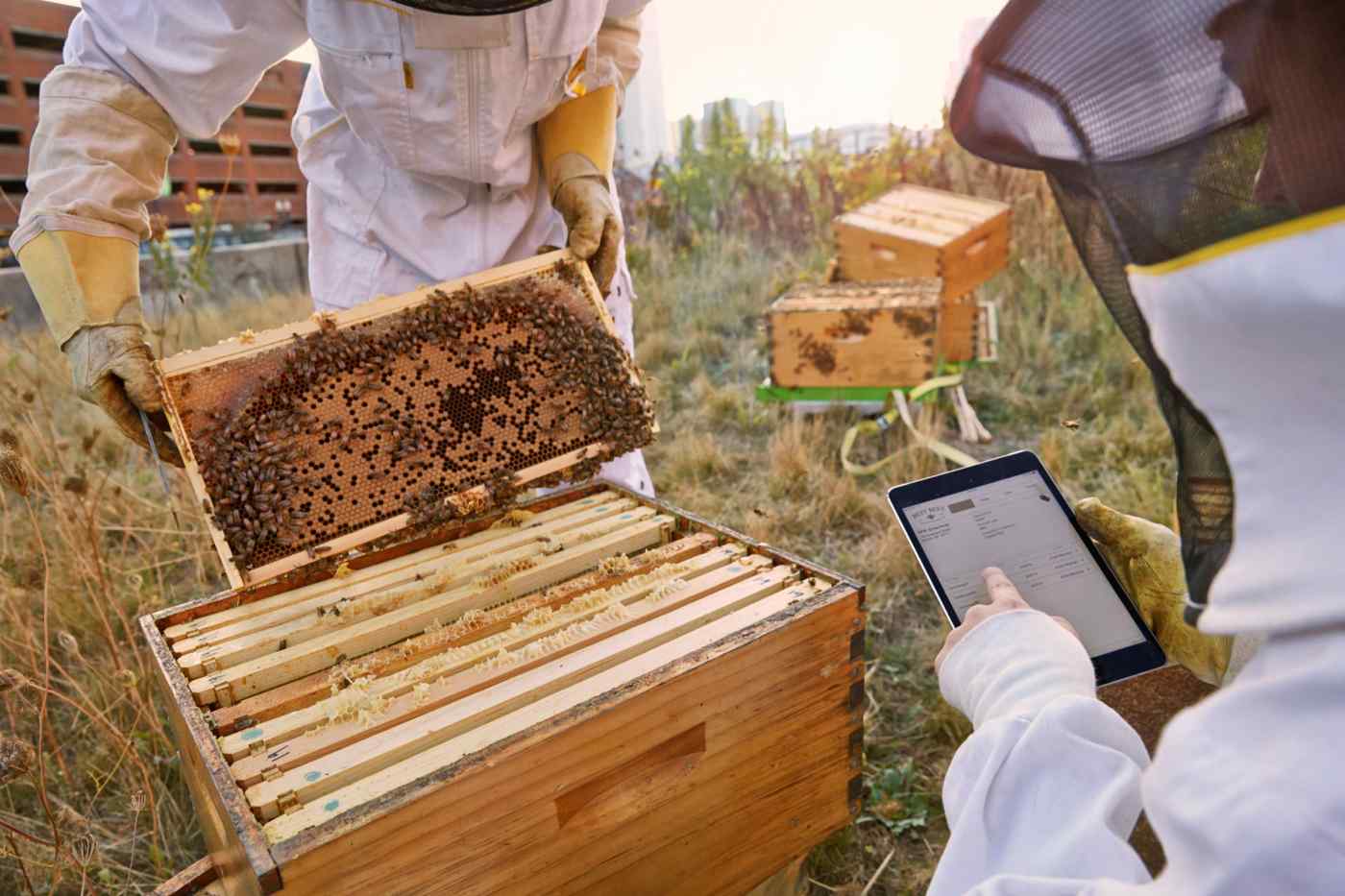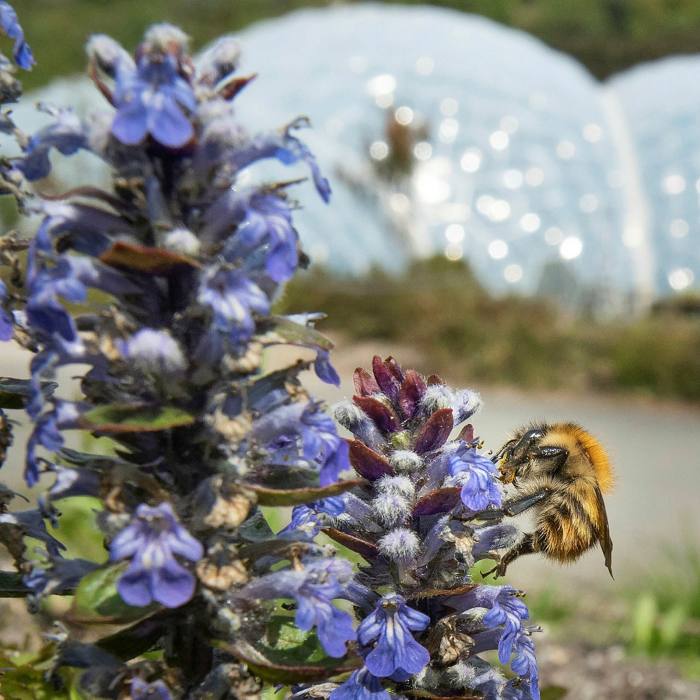Outback in bloom as floodwaters travel hundreds of kilometres into Kati Thanda-Lake Eyre
As I read this article on pollination, and saw the smell and the image of honey 🍯 extraction, memories of my father came flooding back as he tended to 7 beehives in our garden in Vrbov that pollinated the entire Forrest and fields around us …
Unpicking the link between smell and memoriesNature
A new wave of apps and AI wizardry is helping gardeners encourage bees, butterflies and more
When you are sitting in your garden, cup of tea in hand, do you find yourself grumbling when you spot a beetle nibbling your hydrangeas or a fly landing on your prized patch of raspberries? Or do you welcome these tiny visitors, as part of the life of your garden?
Some creatures are difficult to like but, as the threat of an insect apocalypse looms, it is clear we need to try harder to get along. In Britain, flying insects alone have declined as much as 60 per cent in the past 20 years, a survey by Buglife and Kent Wildlife Trust suggests.
“We need to have more empathy for insects, which are vital for ecosystems to flourish,” says UK-based artist Alexandra Daisy Ginsberg, whose work investigates our troubled relationship with nature and technology. She has developed an algorithmic design tool to create gardens that encourage bees, beetles, moths, wasps, butterflies and other insects to thrive. Pollinator Pathmaker is part of a new wave of apps and gadgets that are sensitising us to their needs and encouraging us to rethink who — and what — our gardens are for.
Pollinators play an essential role in supporting biodiversity and contribute more than £500mn a year to UK agriculture and food production, according to official figures. But they are disappearing due to habitat loss, pesticides, invasive species or climate change.
46% Reported drop in US honey bee colonies in just one year, from April 2020 to April 2021
While chemical-heavy farming has much to answer for, our penchant for turning our gardens into “outdoor rooms”, treating creepers like wallpaper, lawns like carpets and sanitising our flower beds with sprays is compounding the problem. But Ginsberg’s Pollinator Pathmaker — developed as part of an art commission for the Eden Project in Cornwall — takes human tastes out of the equation. The online tool, hosted on pollinator.art, uses the algorithm to generate planting schemes that attract diverse pollinating species.
Once you have entered your plot size and selected your site’s light exposure and soil type, it will pick from 150 plants to create a unique design, giving you planting instructions to download. Choose “pollinator vision” and you can see your garden through the eyes of an insect, with the software approximating colours it would detect. “I’m using technology to stop us seeing the world from just our own perspective,” says the artist. She developed the algorithm with the Eden Project’s horticulturalists, pollinator experts and an AI scientist.
The first edition of the Pollinator Pathmaker artwork — a 55-metre-long garden — began to bloom at the Eden Project this spring. “It’ll be like granny’s herbaceous border on acid when it’s fully grown,” says Ginsberg.
“The giant Echium pininana, for example, are like skyscrapers for pollinators, attracting honey bees, bumblebees, solitary bees, butterflies and moths.” Aesthetes may balk at the seemingly random juxtapositions of heights, colours and shapes: the echiums, when mature, will explode out of drifts of purple loosestrife, interspersed with acid green Euphorbia corallioides (magnets for hoverflies) and yellow Verbascum nigrum spears (attracting bees).
It has an eccentric charm, however, incorporating some deliberate stripes that act as flight paths (or “traplines”) for specific bee species to help them find the fastest route between flowers, alongside clumps for pollinators such as beetles that explore plants more randomly.
Another edition of the artwork was planted in London’s Kensington Gardens in April, as part of the Serpentine Galleries’ Back to Earth exhibition, and Ginsberg is now developing a plant palette to suit Germany’s northern region for an iteration at the LAS Berlin art foundation. Insects in Germany need all the help they can get: a 2017 study at Radboud University found that the abundance of flying species had plummeted by 75 per cent in protected areas over the previous three decades.
There are plenty of low-tech ways to attract pollinators to your garden, of course. Websites such as Bumblebeeconservation.org and RHS.org.uk provide helpful lists of plants to choose from, with Dr Andrew Salisbury, the RHS’s principal entomologist, advising that you should fill your garden with as wide a range of plants as possible that will flower throughout the year.
The UK government also offers some basic tips as part of its Pollinator Action Plan, such as mow your lawn less often, avoid disturbing nests and think twice before using pesticides. But the algorithm does a computation that would be challenging to achieve without help. “The database knows what plants serve specific types of insects — such as foxgloves, which attract long-tongued bumblebees — and those that serve many species,” says Ginsberg.
“It will balance out those specialist and generalist plants so it can serve the maximum diversity of pollinators, while ensuring the garden will flower year-round. That’s hard to do on your own.” Pollinator Pathmaker is conceived as a call to action to encourage us to consider the wellbeing of other species. In recent decades, technology has often exacerbated our separation from nature, but now it is increasingly awakening us to its plight.
In May, the UK government called on Britons to use the new Flower-Insect Timed Count (FIT Count) app to record insects in their gardens and elsewhere, as part of its own attempts to stem the loss of pollinators. It is encouraging people to give up just 10 minutes of their time to count pollinating insects “to help us track their numbers and movements, and support our efforts to reverse the decline of these vital species,” said the then environment minister, Rebecca Pow at the launch of FIT Count, developed by the Centre for Ecology and Hydrology and supported by Defra. FIT Count joins an array of apps and websites that encourage us to become caretakers of the natural world and its tiny inhabitants.
Users of the Seek smartphone app, for example, can point their cameras at insects and plants to identify them, with the data passed on to scientists (if people opt in), while iRecord Butterflies sends sightings to the “Butterflies for the New Millennium” national recording scheme. I’m using technology to stop us seeing the world from just our own perspective Alexandra Daisy Ginsberg Garden designer Tom Massey urges his clients to use them, to deepen their connection with their environments. “They encourage citizen science,” he says. “Everyone can become a plant or insect hunter, and record species they find in the wild, or in their gardens. The data can then be used to track and monitor distribution of certain species that may be rare, or under threat.”
Seeing the results of your planting efforts reflected in increased numbers of insect species is also an encouraging pat on the back. Bees benefit from a better public image than most insects, thanks to the honey they produce and their efficiency as pollinators. It explains why a raft of bee tech is emerging to help their cause. “Bees are fundamentally important to about a third of the food we eat every day,” says Fiona Edwards Murphy of Irish company ApisProtect, in a promotional video. It has developed wireless in-hive sensors that monitor temperature, humidity, sounds and acceleration, helping commercial and hobbyist beekeepers to take action when needed.
In the US, beekeepers lost 46 per cent of their honey bee colonies between April 2020 to April 2021, according to the Bee Informed Partnership, a collaboration of national research labs. Key causes of colony collapse include the rapid spread of the parasitic varroa mite — aided by warming temperatures — habitat loss and lack of nutrition. Boston-based Best Bees Company installs hives on corporate and residential properties in urban centres and uses software to monitor colony health, giving the data to Harvard University, MIT, Nasa, as well as hive owners. “We’ve discovered that plant species diversity is vital,” says founder Noah Wilson-Rich. “The more species they pollinate, the better their health.” Good nutrition can also help bees to metabolise pesticides.
To help create habitats in which bees can thrive, the company is also developing a “smart hive”. It will react to changes in temperature and humidity without human intervention. Insect tech is getting increasingly sophisticated. Bulgarian company Pollenity already offers Beebot sensors to hobbyist beekeepers, and aims to bring a robotic insect to market soon, after live-testing it this summer. Their RoboBee performs the “waggle dance” of a bee to guide a hive’s swarm to flowers and away from dangers. “The beauty of this system is being able to tap into the intricate communication methods of the bees to influence them,” says chief executive Sergey Petrov of the technology, developed by researchers at the Free University of Berlin. “It could be a game-changer in navigating bees away from pesticides.” If catastrophe strikes and bees die out, researchers at Harvard University are developing a RoboBee that will pollinate plants itself. In the UK, start-up company Olombria, founded by designer Tashia Tucker, is helping the underdogs of the pollinator world become more efficient. Hoverflies account for 30 per cent of all pollination, despite the fact they are easily distracted and often roam off before carrying pollen between plants. Olombria’s AI pollination system includes sensors, cameras and chemical signalling devices that can be placed in strategic spots in a field to direct hoverflies to plants in bloom. The undesirable traits of some insects — from stinging and biting to damaging foliage and fruit — often make them disagreeable guests in gardens and have slowed down both scientific research and technological innovation. We know that wasps, for example, are important pollinators but people’s disdain for them and their affection for bees means we have far fewer studies into the former’s ecological benefits.
Recommended
The problem with wasps is people,” writes professor Seirian Sumner, a behavioural ecologist and entomologist at University College London, in her new book Endless Forms: The Secret World of Wasps. Last year she co-authored a review of 500 academic papers to begin quantifying their value. It found that wasps help pollinate 960 plant species, with 164 plants — largely orchid varieties — completely reliant on them. Wasps also act as natural pesticides, feeding on aphids and caterpillars that damage plants. The occasional sting, it seems, is a small cross to bear for the benefits they bring to your garden — as long as you are not allergic to them, that is. The RHS is now trying to help us see the positives in insects we have long maligned, perhaps inspiring future technological innovation to help them thrive. Earlier this year it announced it will no longer label any garden wildlife as “pests”, instead doing positive PR for misunderstood insects like wasps, moths, ants, slugs and snails. “Insects play an invaluable role in biodiversity so we are trying to encourage a more tolerant attitude,” says Andrew Salisbury.
Different plant and insect species also co-evolve together, which means banishing one will disrupt others. Salisbury points out how gardeners regularly complain about the damage that winter moth caterpillars wreak to foliage on trees and shrubs, but moths are useful pollinators and birds such as blue tits time their egg hatching to their arrival, relying on them to rear their chicks. “What you lose in perfection from them, you gain in birdsong and a more lively garden,” he says. Recommended ReviewScience books Book review: 'Silent Earth' by Dave Goulson — a plea for the pollinators Nature doesn’t conform to human ideals, says Tom Massey.
“Things that people see as messy have so much benefit.” He encourages his clients not to clear dead wood from their gardens, for example, to allow solitary bees and other insects to make it their home. But if our gardens don’t live up to our conventional standards of beauty, will we care for them as we should? “There’s a different kind of joy you get from watching pollinators in action,” says Alexandra Daisy Ginsberg. “Seeing a bumblebee’s bottom sticking out of a spotted deadnettle flower is a sublime aesthetic experience in itself.” It’ll take more than a few algorithms and gadgets to avert an insect apocalypse, of course. But this new wave of innovations could help us understand that our gardens — and technology — can be designed for the benefit of other creatures beyond ourselves.
Find out about our latest stories first — follow @FTProperty on Twitter or @ft_houseandhome on Instagram




 confession is run through multiple times, ala Groundhog Day. The rehearsal probably cost five hundred thousand or more. The enormous difference between the scale of the rehearsal and the fib is part of the point. Kor is an expert on the trivial. Fielder himself rehearses the rehearsal.
confession is run through multiple times, ala Groundhog Day. The rehearsal probably cost five hundred thousand or more. The enormous difference between the scale of the rehearsal and the fib is part of the point. Kor is an expert on the trivial. Fielder himself rehearses the rehearsal.